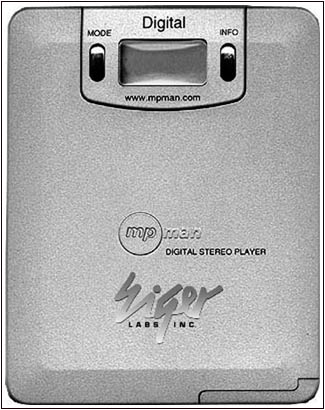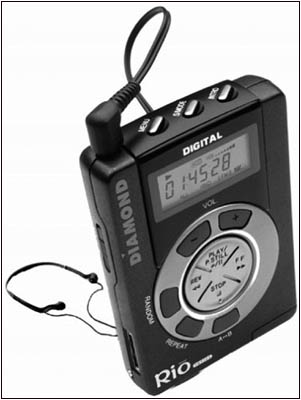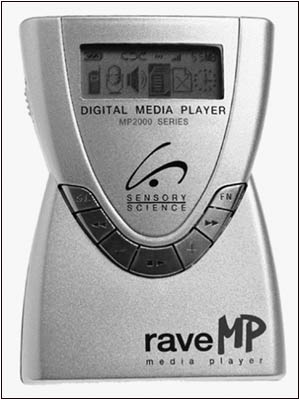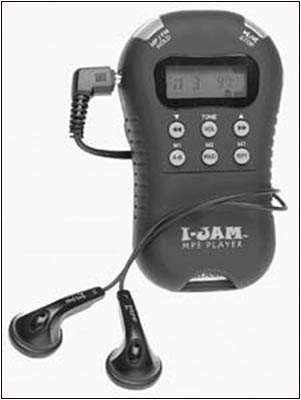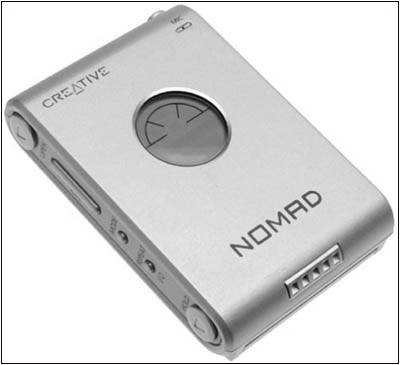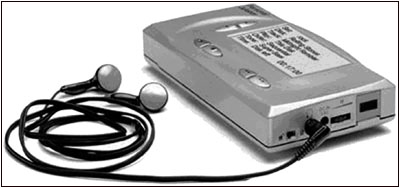Of Old Radios And Related Items--Published Monthly
Collecting MP3 Portables -- Part 1
BY RICHARD MENTA
Web Edition
Richard Menta offers a suggestion for collectors who give thought to what might be valuable years from now. Why not think of today's MP3s as the Regency TR-1s of the future? (Editor)
All collectors wish they could return to 1954 and pick up a new and perfect Regency TR-1 transistor radio or to the 1930s to preserve a rare prewar set. It occurred to me that, as editor of MP3 Newswire, I had inadvertently collected many of the first generation MP3 portables as I reviewed them for publication. Aren't these players today's Regency TR-1? If so, wouldn't now be a great time to start collecting these early portables, when they are easily available and cheap?
Contemporary audio equipment is not always something an antique collector strives to acquire, but I could easily see how 30 years from now some of these digital music players could be coveted. I already brought a box filled with several early players to my New Jersey Antique Radio Club meeting last year, and while the reaction was mixed (this was new technology, after all), their distinct styles and dramatic shapes were a welcomed respite from today's generic radios.
MP3s with Collecting Promise
For those who are intrigued by my suggestion here is a list of the key MP3 portables with the best collecting promise, all of which I reviewed when first released.
Figure 1. The Elger Labs MPMan F10, the first MP3 player, appeared in 1998.Eiger Labs MPMan F10. Appearing in 1998, the MPMan, shown in Figure 1, was the first MP3 player. Spartan and square, the F10 sold for $250 and came with 32MB of memory. At a rough average of 1MB for every minute of music, the player could hold eight 4-minute songs. Not a lot, but it sold well. You could upgrade the memory to 64MB by sending the unit back to Eiger labs with a check for $69 plus $7.95 shipping.
Figure 2. Diamond Rio PMP300, the second MP3 portable, put MP3 on the map, as it became a hit for the 1998 Christmas market.Diamond Rio PMP300 (1998). It was the commercial success of this second MP3 portable that put MP3 on the map. Following the MPMan by just a couple of months, the 32MB Rio PMP300, shown in Figure 2, became a surprise smash hit for the Christmas '98 season. Sales far exceeded expectations and stayed strong long after the holiday.
This success convinced many that digital music was the future, and before long, dotcom money poured into online digital music initiatives and start-up MP3 portable companies. The impact of this little player was so strong that the record industry sued Diamond, claiming it encouraged music piracy. The record industry lost the case.
Figure 3. The 1999 Sensory Science RaveMP 2100 was the first player to have 64MB of built-in memory.Sensory Science RaveMP 2100 (1999). Released in the summer of 1999, the RaveMP 2100, shown in Figure 3, was the first player to appear with 64MB of built-in memory, doubling the amount of music that users could listen to out of the box. Furthermore, an expansion slot allowed the unit to expand to 96MB. With a built-in microphone, this set was the first unit to add voice record capabilities.
Figure 4. The I-Jam IJ-100 was a strong seller with its tiny dimensions and offer of a radio and a choice of five colors.I-Jam IJ-100 (1999). With dimensions of only 3 inches long and 1/2 inch thick, the I-Jam, shown in Figure 4, proved how tiny MP3 portables could be. Weighing only 2.5 oz., the 32MB I-Jam included an FM radio and came in five colors -- the first player to offer either option. Colors included Black Rhino, Silver Bullet, Lemon Drop, Razz Jazz Red, and Chi-Town Blue. It was a strong seller, but the undercapitalized I-Jam Company ran out of funds and folded in 2002.
Figure 5. The Creative Labs Nomad.Creative Labs Nomad (1999). This 32MB portable, shown in Figure 5, was introduced in June of 1999 for a healthy $429. It came clad in a magnesium body, and like the RaveMP, it had voice recording and an FM tuner. The Nomad was the first to offer a docking station so users didn't have to mess with wires every time they wanted to refresh songs on the player.
Figure 6. Remote Solutions Personal Jukebox PJB-100.Remote Solutions Personal Jukebox PJB-100 (1999). By the fall of 1999, all MP3 portables came with either 32MB or 64MB of memory, capable of holding only 7 to 20 song files at a time. This was the most limiting factor of early MP3 portables.
A company called Remote Solutions smashed that limitation with a clever idea. By utilizing a laptop hard drive for storage rather than low capacity flash memory, they produced a unit that held over a thousand song files, thereby inventing a jukebox MP3 portable. Listing for $799, the PJB-100, shown in Figure 6, premiered at the end of 1999 with 4.8GB of storage, enough for 1,200 songs.
There was a trade-off for such high capacity, as the drive made the PJB-100 both large and heavy. The grandfather of the Apple iPod, jukebox portables are now the dominant type of MP3 player sold today.
All photos courtesy of the manufacturers.
(Richard Menta, 58 Cedar Ave., #1 Highland Park, NJ 08904)
A member of the New Jersey Antique Radio Club, Richard Menta is also the editor of www.MP3newswire.net. He started the web publication in December of 1998, inspired by the success of the Rio PMP300. He has been collecting radios since 1996, most of them pre-1940 models.
What is MP3 Audio?
MPEG is an acronym for the Moving Picture Experts Group. This committee is responsible for developing international standards for compression in motion picture and studio applications. One such standard is MPEG-1 Layer-3, commonly referred to as MP3.
MP3 is a technique used to compress audio signals by a factor of about 12. The compression process is based upon limitations of the human ear. For example, sounds that immediately follow a sudden loud musical passage tend to be masked by the loud sound. Also, the ear has difficulty in distinguishing closely spaced tones. MP3 processing eliminates those sounds that the ear cannot hear or has difficulty hearing. The result is a smaller or compressed digital package that can be easily sent over the Internet or recorded.
Reference: IEEE Spectrum, September 2004
| [Free Sample] [Books, etc., For Sale] [Subscribe to A.R.C./Renew] [Classified Ads] [Auction Prices] [Event Calendar] [Links] [Home] [Issue Archives] [Book Reviews] [Subscription Information] [A.R.C. FAQ] URL = http://www.antiqueradio.com/Dec04_Menta_mp3pt1.html Copyright © 1996-2004 by John V. Terrey - For personal use only. Last revised: October 31, 2004. For Customer Assistance please contact ARC@antiqueradio.com or call (866) 371-0512 Pages designed/maintained by Wayward Fluffy Publications
Antique Radio Classified |
